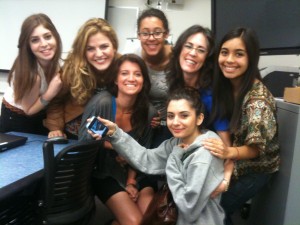The intimacy born of learning face-to-face is a misattribution. It’s not the face or the body that conveys intimacy, but shared, dynamic experiences of time.
Virtual learning environments are awkward because the software can’t yet pivot between the dynamic flux in time dimensions when I’m face-to-face in a classroom with some students and also engaging virtually via classroom software with others. It’s a bizarre truth that the same students who will slouch in sweats around a conference table will sometimes refuse to come on-camera unless they look “camera ready.” Men and women alike; it doesn’t skew by gender. As computing power increases, and as a generation of homeschooled learners log their 15,000 K-12 classroom hours in predominantly virtual and hybrid environments, the software’s insufficiency will come to an end.
Will the embodied classroom?
That’s what we’re focused on as we take the measure of MOOCs. That’s what administrators and donors reckon with when they assess whether to invest in the campus’s physical capacity. But “will the embodied classroom end” is not the real question.
Because the new learning is ancient.
Agape, loving-kindness, can’t be dispersed. It’s a specific call or procedure, a transaction that’s both medium- and user-specific. It’s existed for thousands of years passed from body to body in whatever counted as “the classroom” of its day. It will persist if we create conditions for it to flourish. Before ubiquitous computing, agape was a byproduct of physical intimacy and shared dreaming that unfolds in a good class over a semester. “I’m more accustomed to looking at a screen than at my professors,” one student told me after our first virtual class. “But I’m scared that this is what education is going to become.”
I’m not; and I suspect that her fear that “this is what education would become” has been diminished by the durable artifacts of fifteen weeks of nearly constant collaboration with the other three members of “Team Coke.” “I learned how to mic and light a scene,” she told me in office hours outside last week. “We stayed up til 3 with Graham even though he was the only one editing.” I interpret this to mean that at the beginning of the term, Jessi thought the classroom was mine, and that she entered my world when she streamed me inside the screen of her MacBook Pro. Over the term her classroom became anywhere she and her teammates happened to be working: filming at the student center or on John McKay Field; editing and voicing over in her apartment and goofing around with her teammates into the wee hours; arriving, always a little late, into the physical space of our classroom; steaming in herself when she wanted to, and almost always game to push an idea some place unexpected. That’s her classroom. I’m the one who makes sure she can build what she needs and take it anywhere she wants to go.
Students from fifteen years ago, or five years ago, or from last term will Facebook me, or find me via email or Twitter and say, “Did you see Aung San Suu Kyi?…. or….Franzen’s new book?….. or……how Machimima is contracting content for women…..” A woman selling cosmetics a Nordstroms stopped me mid-sentence and said: “you were my literature professor. I recognize your voice.” When did you graduate? I asked. “2004.”
I don’t worry that computers will get smarter and virtual classrooms will remediate embodiment better than they do now. It doesn’t matter to me if my classroom is a little rectangle in a building or a little rectangle above my keyboard. Doors are rectangles; rectangles are portals. We walk through.
What can’t be digitized is love.






This: “I don’t worry that computers will get smarter and virtual classrooms will remediate embodiment better than they do now. It doesn’t matter to me if my classroom is a little rectangle in a building or a little rectangle above my keyboard. Doors are rectangles; rectangles are portals. We walk through.” Really lovely. What you write here speaks to something so important to me re: any kind of online/virtual learning. The learning doesn’t happen on the screen or in the RAM or in the 1s and 0s of the computer code. The learning happens in our heads and hearts and in our fingertips and across the skin on the backs of our neck. I’ve been a classroom teacher primarily since 1999 but have taught online and hybrid classes since 2001. Something has happened to me in the last year and a half — my online work has come alive, grown ecstatic, in a way that it had never been before. What’s most wonderful, though, is the way this new revelation infuses (and is infused by) the other teaching I continue to do. “What can’t be digitized is love.” Your students are lucky folk.
Pingback: My #hybrid Life | solo
Pingback: The Digital Humanities is About Breaking Stuff | Edutone Reader
Pingback: Hybrid Pedagogy | The Digital Humanities is About Breaking Stuff
Pingback: The Digital Humanities is About Breaking Stuff - Hybrid Pedagogy
Pingback: Critical Digital Pedagogy: a Definition - Hybrid Pedagogy
Pingback: Critical Digital Pedagogy: A Definition | Indiana Jen
Pingback: Re-blogging ‘Critical digital pedagogy: a definition’ | Critical Physiotherapy
Pingback: Critical Digital Pedagogy: a Definition | News from UW-Madison Continuing Studies
Newly hired LAUSD teachers have become students for the week as they learn some unusual strategies to accommodate students growing needs for social and emotional support.